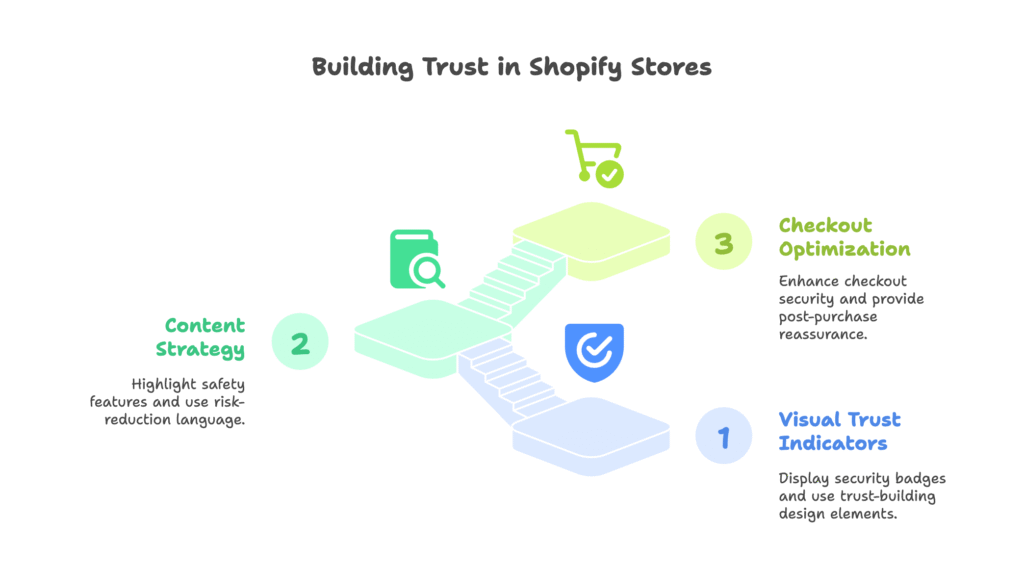Picture this: You’re browsing online for a $500 air purifier for your baby’s room. Two identical products appear on your screen. One shows security badges, detailed safety certifications, and a money-back guarantee. The other? Just a basic product page. Which one makes your heart rate slow down? Which one gets your click?
If you’re like most people shopping for something important, you chose the first option without even thinking about it. But here’s what’s fascinating: your brain made that decision in milliseconds, driven by deep-seated psychological triggers you probably didn’t even notice.
Why does this matter for your Shopify store? Because when customers are spending their hard-earned money on products that matter to them, safety isn’t just a nice-to-have feature – it’s the invisible force that either opens wallets or slams them shut.
In this guide, you’ll discover exactly how safety works as an emotional trigger in high-consideration purchases, why it’s so powerful, and most importantly, how to ethically use this knowledge to boost your conversions. Ready to unlock the psychology behind your customers’ buying decisions? Let’s dive in.
The Psychology of Safety in Purchase Decisions
Let’s start with what’s happening inside your customer’s brain when they’re considering a significant purchase. Understanding this biological and psychological foundation will help you see why safety triggers are so incredibly powerful.

Your Brain on Shopping: The Neurological Reality
When someone visits your Shopify store to buy something expensive or important, their brain doesn’t just casually browse. Instead, three key areas spring into action like a security team evaluating a potential threat.
First, the amygdala – your brain’s alarm system – immediately starts scanning for danger signs. Is this website trustworthy? Could this be a scam? This happens so fast you don’t even realize it’s occurring. If the amygdala detects too many “red flags,” it can literally block the purchase decision before rational thinking even begins.
Meanwhile, the prefrontal cortex takes on the role of the careful analyst, especially for high-value purchases. It’s asking questions like: “What if this product doesn’t work?” “What if I waste my money?” “What if there’s something better out there?” This is where logical safety concerns get processed.
But here’s the really interesting part: when customers feel safe and trust your store, their brain releases oxytocin – the same hormone involved in bonding and trust between people. This creates a positive feedback loop that makes them more likely to complete the purchase and even become repeat customers.
Safety as a Fundamental Human Need
You’ve probably heard of Maslow’s hierarchy of needs, but have you thought about how it applies to e-commerce? Safety sits right there at the second level – it’s more basic than feeling loved, respected, or self-actualized. This means until your customers feel safe, they literally cannot progress to caring about your brand story, your cool features, or your amazing customer service.
In the context of online shopping, this safety need transforms into very specific concerns:
- Financial security: “Will I get my money back if something goes wrong?”
- Product quality safety: “Is this product actually safe to use?”
- Transaction security: “Is my credit card information protected?”
- Decision security: “Am I making the right choice?”
Fear: The Hidden Purchase Driver
Here’s something that might surprise you: fear of loss is often a stronger motivator than desire for gain. Your customers aren’t just thinking about what they’ll gain from your product – they’re intensely focused on what they might lose.
This shows up in two main ways in high-consideration purchases:
- FOMO (Fear Of Missing Out): “What if this deal disappears and I never find something this good again?”
- FOMU (Fear Of Messing Up): “What if I choose wrong and regret this decision for months?”
The digital environment actually amplifies these fears. Unlike in a physical store where you can touch products and talk to salespeople, online shopping requires customers to make significant decisions based on limited sensory input. This uncertainty triggers even stronger safety concerns.
Key Insight: Your customers’ brains are constantly asking “Is this safe?” before they ask “Do I want this?” Understanding this fundamental sequence is crucial for optimizing your store’s conversion rates.
Now that we understand the psychology behind safety as a purchase driver, you might be wondering: “How does this actually show up in different types of products?” Each product category triggers different safety concerns, and that’s exactly what we’ll explore next.
Safety Triggers in High-Consideration Products
Not all products trigger the same safety concerns. A $50 t-shirt and a $500 baby monitor activate completely different alarm bells in your customer’s mind. In this section, we’ll break down exactly what safety concerns dominate different product categories and how you can address them.
Category-Specific Safety Concerns
Let’s look at how safety manifests across different types of high-consideration products:
| Product Category | Primary Safety Concern | Emotional Trigger |
|---|---|---|
| Health Supplements | Ingredient transparency | Physical wellbeing fears |
| Luxury Goods | Counterfeit protection | Investment security |
| Electronics | Warranty/performance guarantees | Financial waste anxiety |
| Baby Products | Testing certifications | Parental protection instinct |
Notice how each category taps into a different type of fear. Health supplements trigger our most primal fear – harm to our physical body. Luxury goods activate our fear of being deceived or looking foolish. Electronics trigger the fear of wasting money on something that breaks. Baby products? They trigger the strongest protective instincts humans have.
Financial Safety: The Universal Concern
Regardless of category, every high-consideration purchase involves significant financial safety concerns. Your customers are essentially asking: “What happens if this goes wrong?”
The three pillars of financial safety that customers look for are:
- Purchase Protection Policies: Clear, easy-to-understand refund and return policies
- Money-Back Guarantees: Risk-free trial periods that remove the fear of buyer’s remorse
- Payment Security: Multiple secure payment options, including installment plans for expensive items
Here’s what’s interesting: customers don’t just want these protections to exist – they need to see and understand them easily. A great policy buried in fine print provides no safety comfort at all.
Information Security in the Digital Age
Beyond financial and product safety, modern consumers are increasingly concerned about their personal information. Data breaches make headlines regularly, and customers are more aware than ever of privacy risks.
The three key informational security elements your customers evaluate are:
- Data Privacy: How will you use their personal information?
- Storage Security: How is their payment information protected?
- Communication Preferences: Will they be bombarded with emails, or can they control what they receive?
Mobile transactions add another layer of security concerns. When customers shop on their phones, they’re often in public spaces, using potentially unsecured networks, and dealing with smaller screens that make it harder to verify security indicators.
Remember: Safety concerns aren’t just rational – they’re deeply emotional. A customer might logically know your store is secure, but if they don’t feel safe, they won’t buy.
Understanding these various safety concerns is just the beginning. The real question is: how do you actually implement solutions that address these concerns on your Shopify store? That’s where our implementation framework comes in.
Implementation Framework for Shopify Merchants
Now we get to the practical stuff. You understand why safety matters and what concerns your customers have. But how do you actually build safety into your Shopify store in a way that converts browsers into buyers? This section provides a step-by-step framework you can implement immediately.

Visual Trust Indicators: Making Safety Visible
The first rule of safety in e-commerce: if customers can’t see it, it doesn’t exist in their minds. Security features hidden in your footer or buried in policy pages might as well not exist.
Security Badge Placement:
- Above-fold SSL certification: Display your SSL certificate badge prominently on your homepage and product pages where customers can see it without scrolling
- Payment processor logos: Show Stripe, PayPal, or other trusted payment processor logos directly in your checkout flow
- Third-party verification seals: Display badges from Norton, McAfee, or industry-specific certification bodies
Design Elements That Build Trust:
- Color psychology: Use blue tones for trust-building elements and green for security indicators
- White space utilization: Clean, uncluttered design suggests professionalism and reliability
- Font selection: Choose professional, easy-to-read fonts that convey credibility
Content Strategy for Safety Reinforcement
Words matter enormously when it comes to building safety perceptions. The way you describe your products, policies, and processes can either amplify or diminish feelings of security.
Product Description Frameworks:
- Safety-first feature highlighting: Lead with safety features before describing benefits
- Risk-reduction language: Use phrases like “tested and certified,” “quality guaranteed,” and “risk-free trial”
- Certification-forward bullet points: Make certifications and testing standards prominent in your bullet points
Review Curation Techniques:
- Safety-focused testimonials: Highlight reviews that mention product reliability, quality, and peace of mind
- Verified purchase badges: Clearly mark which reviews are from actual buyers
- FAQ optimization: Create an FAQ section that proactively addresses common safety concerns
Checkout Experience Optimization
The checkout process is where safety concerns peak. This is the moment when customers are about to hand over their money and personal information. Every element of your checkout needs to reinforce security and reduce anxiety.
Security-Enhanced Design:
- Progress indicators: Show customers exactly where they are in the checkout process
- Security messaging: Include micro-copy that reinforces security at each step
- Trust badges: Display security badges prominently near payment fields
Post-Purchase Reassurance:
- Order confirmation security: Immediately confirm the order with clear security messaging
- Shipping protection: Offer (and explain) shipping insurance options
- Support accessibility: Make it crystal clear how customers can reach you if something goes wrong
Pro Tip: Add a small amount of friction at checkout if it enhances security perception. Customers are often more comfortable with a checkout that feels secure than one that feels too easy.
But how do you know if your safety implementations are actually working? You can’t optimize what you don’t measure. Next, we’ll explore exactly how to track and improve your safety-related conversion factors.
Measurement and Optimization
Implementing safety features is just the beginning. The real magic happens when you start measuring how these features impact customer behavior and continuously optimize based on data. Here’s how to turn your safety implementations into a conversion optimization machine.
Key Safety Perception Metrics
Traditional e-commerce metrics like conversion rate and bounce rate tell you what’s happening, but they don’t tell you why. To optimize safety perceptions, you need metrics that specifically measure how customers interact with your trust-building elements.
Trust Signal Interaction Rate (TSIR): This measures how often visitors click on, hover over, or otherwise interact with your security badges, guarantees, and trust indicators. A low TSIR might mean your trust signals aren’t prominent enough or aren’t relevant to your customers’ concerns.
Security Feature Engagement Score: Track which safety-related pages (return policy, shipping information, contact us) customers visit before making a purchase. High-converting customers often visit these pages, while non-converters skip them entirely.
Abandonment Reduction at Security Touchpoints: Measure cart abandonment specifically at points where you’ve implemented security enhancements. If abandonment increases after adding security features, you might be creating too much friction.
A/B Testing Framework for Safety Elements
Not all safety implementations work equally well for all audiences. A/B testing helps you find the perfect balance between security and conversion for your specific customers.
Security Badge Variations:
- Test different badge placements (header vs. footer vs. inline with products)
- Compare industry-specific certifications vs. general security badges
- Experiment with badge sizes and colors
Trust Guarantee Placement:
- Test money-back guarantees on product pages vs. checkout pages
- Compare prominent guarantee messaging vs. subtle mentions
- Experiment with time-limited vs. unlimited guarantees
Safety Messaging Tone:
- Compare authoritative language (“Certified secure”) vs. reassuring language (“Your info is safe with us”)
- Test detailed explanations vs. simple statements
- Experiment with different urgency levels in safety messaging
Customer Feedback Analysis
Numbers tell you what customers do, but feedback tells you why they do it. Systematic analysis of customer feedback can reveal safety concerns you never knew existed.
Sentiment Analysis: Use tools to analyze customer reviews, emails, and chat logs for safety-related keywords and sentiments. Look for patterns in concerns about security, reliability, and trustworthiness.
Safety Perception Surveys: Send brief post-purchase surveys asking specifically about security perceptions. Questions like “How confident did you feel about the security of your purchase?” can provide invaluable insights.
Cart Abandonment Exit Surveys: Implement pop-up surveys when customers abandon their carts, specifically asking about concerns that prevented them from completing their purchase.
Important Note: Measure both hard metrics (conversion rates, time on page) and soft metrics (customer satisfaction, perceived trust) to get a complete picture of your safety implementations’ effectiveness.
All this measurement and optimization is great in theory, but what does it look like in practice? Let’s examine some real-world case studies that demonstrate the power of safety-focused optimizations.
Case Studies and Results
Nothing beats real-world examples to show the power of safety-focused optimization. These case studies demonstrate how different types of Shopify stores have successfully implemented safety triggers to dramatically improve their conversion rates.
Premium Electronics Retailer: The Power of Warranty Transparency
The Challenge: A Shopify store selling high-end audio equipment was receiving dozens of pre-purchase questions about warranties, returns, and product reliability. Customer service was overwhelmed, and many potential customers were abandoning carts after browsing for extended periods.
The Strategy: Instead of hiding warranty information in the fine print, they made it the star of their product pages. Each product page featured:
- A prominent warranty information box right below the add-to-cart button
- Detailed explanations of what the warranty covers
- Clear steps for warranty claims
- Customer testimonials specifically about warranty experiences
The Results: Within six months, they saw a 47% reduction in pre-purchase questions and a 32% increase in conversion rate. More importantly, customer satisfaction scores increased significantly because buyers felt more confident about their purchases from the start.
Natural Supplement Brand: Ingredient Transparency Wins Trust
The Challenge: A supplement company was struggling with high cart abandonment rates, especially for their premium products. Customer feedback revealed concerns about ingredient sourcing and safety testing.
The Approach: They implemented a comprehensive transparency strategy:
- Third-party testing certificates displayed prominently on product pages
- Detailed ingredient sourcing information
- Lab test results available via QR codes on product images
- Video testimonials from their quality control team
The Outcome: The transparency approach led to a 28% higher average order value and a 53% decrease in cart abandonment. Customers were not only buying more frequently but also purchasing higher-priced premium products.
Luxury Fashion Merchant: Authentication Builds Premium Value
The Challenge: A luxury fashion retailer was losing sales to customers worried about counterfeit products. Despite selling only authentic items, they couldn’t communicate this effectively to skeptical customers.
The Tactics: They developed a comprehensive authentication communication strategy:
- Authentication certificates for each product
- Photos of authentication details (serial numbers, craftsmanship close-ups)
- Partnerships with authentication services
- Secure shipping with tracking and insurance messaging
The Impact: These changes resulted in a 67% reduction in return rates and a 41% increase in first-time buyer conversions. Perhaps most importantly, they were able to maintain premium pricing while building customer trust.
Common Thread: Notice that all these successful case studies shared one key element – they made safety and trust visible and prominent, rather than hiding it in fine print or assuming customers would find it.
These results are impressive, but they raise an important question: how do you implement these tactics ethically? After all, the goal is to build genuine trust, not manipulate customers. Let’s explore the ethical considerations next.
Ethical Considerations
With great power comes great responsibility. Understanding how to trigger safety emotions in customers is powerful, but it’s crucial to use this knowledge ethically. The goal should always be building genuine trust, not exploiting fears for short-term gains.
Avoiding Fear Exploitation
There’s a fine line between informing customers about benefits and manipulating their fears. Ethical safety marketing focuses on providing information that helps customers make better decisions, not creating artificial anxiety to drive sales.
Informing vs. Manipulating:
- ✅ Ethical: “Our products are lab-tested for purity and safety”
- ❌ Manipulative: “Don’t risk your family’s health with untested products”
Balanced Presentation: Always present both benefits and realistic limitations. If you offer a 30-day money-back guarantee, be clear about what it covers and what it doesn’t. Transparency builds more trust than overselling ever could.
Vulnerability-Sensitive Design: Remember that some customers may have anxiety disorders or past negative experiences with online shopping. Design your safety messaging to reassure without triggering unnecessary anxiety.
Authenticity Requirements
Every trust signal you display must be genuine and verifiable. Fake badges, false certifications, or misleading guarantees will eventually be discovered and can destroy your brand’s reputation permanently.
Verification Systems: Implement systems to verify that all security badges and certifications are current and legitimate. Many certification bodies provide verification tools that customers can use to check authenticity.
Substantiation Protocols: Be able to back up every safety claim you make. If you claim “bank-level security,” be prepared to explain exactly what that means and how you implement it.
Transparency in Limitations: Be honest about what you can and cannot guarantee. For example, if you offer shipping insurance, be clear about what types of damage or loss it covers.
Regulatory Compliance
Different industries and regions have specific requirements for safety claims and security representations. Staying compliant isn’t just about avoiding legal trouble – it’s about maintaining customer trust.
Product Safety Frameworks: Understand the regulatory requirements for your specific products. Health supplements, electronics, children’s products, and cosmetics all have different safety standards and disclosure requirements.
Security Representation Standards: Be careful about how you represent your site’s security. Claims about “military-grade encryption” or “unbreakable security” can create legal liability if they’re not accurate.
Data Protection Compliance: With regulations like GDPR and CCPA, transparency about data collection and use isn’t just ethical – it’s legally required in many jurisdictions.
Golden Rule: Would you feel comfortable if your own grandmother shopped at your store based on the safety promises you make? If the answer is yes, you’re probably on the right track ethically.
Ethics aside, what does the future hold for safety triggers in e-commerce? Technology is evolving rapidly, and so are customer expectations. Let’s explore what’s coming next.
Future of Safety Triggers in E-Commerce
The e-commerce landscape is constantly evolving, and so are customer expectations around safety and security. Understanding these trends can help you prepare your Shopify store for the future and stay ahead of customer needs.
Emerging Technologies
New technologies are creating exciting opportunities to enhance customer safety and trust in ways we couldn’t imagine just a few years ago.
Blockchain for Product Authenticity: Blockchain technology is making it possible to create unalterable records of product authenticity and provenance. Luxury goods, pharmaceuticals, and artisanal products are already starting to use blockchain certificates that customers can verify independently.
Biometric Security in Transactions: Fingerprint and facial recognition for high-value transactions are becoming more common. While this adds friction, many customers actually prefer the extra security for expensive purchases.
AI-Powered Risk Assessment: Artificial intelligence is getting better at detecting fraud and assessing transaction risk in real-time. This means security measures can become more personalized – low-risk customers get a smooth experience, while high-risk transactions get extra verification.
Evolving Consumer Expectations
Today’s customers expect more than just basic security – they want comprehensive transparency and control over their shopping experience.
Zero-Knowledge Proof Systems: Customers increasingly want to verify information without revealing unnecessary personal details. Technologies that allow verification without data sharing are becoming more important.
Real-Time Supply Chain Transparency: Consumers want to know not just that a product is authentic, but where it came from, how it was made, and who was involved in its creation. QR codes linking to detailed supply chain information are becoming standard.
Ethical Sourcing Verification: Modern consumers, especially younger ones, consider ethical sourcing and environmental impact as part of “safety.” They want assurance that their purchases don’t cause harm to people or the planet.
Preparing for the Future
While you can’t predict every technological advancement, you can prepare your store for evolving customer expectations around safety and trust.
- Invest in transparency systems: The more information you can provide about your products, processes, and policies, the better prepared you’ll be for future demands
- Stay current with security standards: Regularly update your security implementations and stay informed about new best practices
- Build authentic relationships: Technology changes, but the human need for trust remains constant. Focus on building genuine relationships with your customers
Future-Proofing Tip: The stores that thrive in the future will be those that view safety and trust not as obstacles to overcome, but as competitive advantages to embrace and enhance.
Conclusion: Your Action Plan
Understanding safety as an emotional trigger is just the beginning. The real value comes from implementing these insights in your own Shopify store. Here’s your action plan to get started:
- Audit your current trust signals: Walk through your store as a skeptical customer and identify where safety concerns might arise
- Implement visual trust indicators: Start with security badges and clear guarantee messaging
- Optimize your content: Rewrite product descriptions to lead with safety features
- Test and measure: Start A/B testing different safety implementations and track their impact
- Gather feedback: Ask customers about their safety perceptions and concerns
Remember, building trust through safety triggers isn’t about manipulation – it’s about removing barriers to purchase and helping customers feel confident in their decisions. When customers feel safe, they buy more, return more often, and recommend you to others.
Ready to boost your conversions? Consider exploring Growth Suite for Shopify stores. This intelligent app helps increase conversion rates by strategically presenting personalized, time-limited offers to visitors who need that extra push to purchase – all while maintaining your brand’s integrity and avoiding the pitfalls of aggressive discount tactics.
References
- SiteCentre. (2025, March 7). Psychological Purchasing Triggers: Top Secret Guide. Retrieved from https://www.sitecentre.com.au/blog/psychological-purchasing-triggers
- MAK Digital Design. (2025, March 27). Using Emotional Triggers in Your eCommerce Design. Retrieved from https://makdigitaldesign.com/user-experience-user-interface/use-emotional-triggers-in-your-ecommerce-design/
- Consumers International. (n.d.). The Challenge of Protecting Consumers from Unsafe Products. Retrieved from https://www.consumersinternational.org/media/155104/productsafetyreport-full.pdf
- Shopify. (2024, December 10). Buying Motives: How To Target Ecommerce Buyer Motivations. Retrieved from https://www.shopify.com/blog/buying-motives
- Total Retail. (2019, June 5). The Psychology of an Online Shopper: Merchants Must Prioritize Security. Retrieved from https://www.mytotalretail.com/article/the-psychology-of-an-online-shopper-why-merchants-must-prioritize-security/




